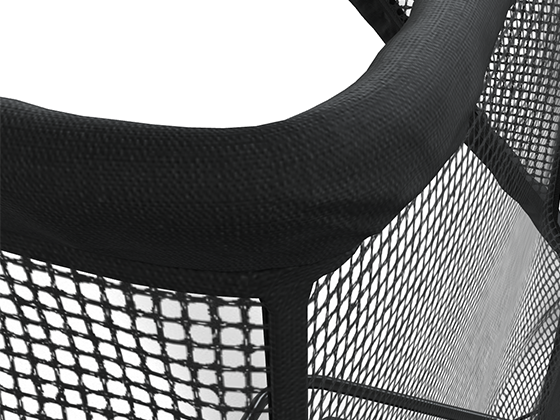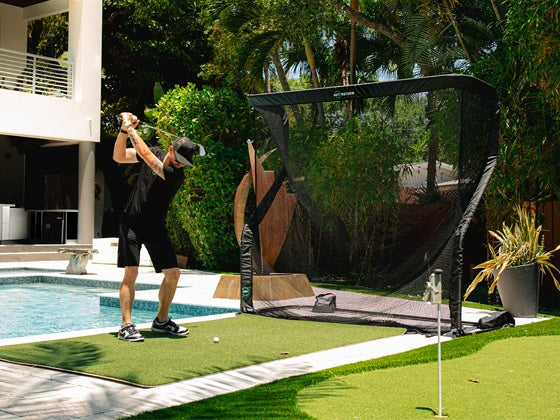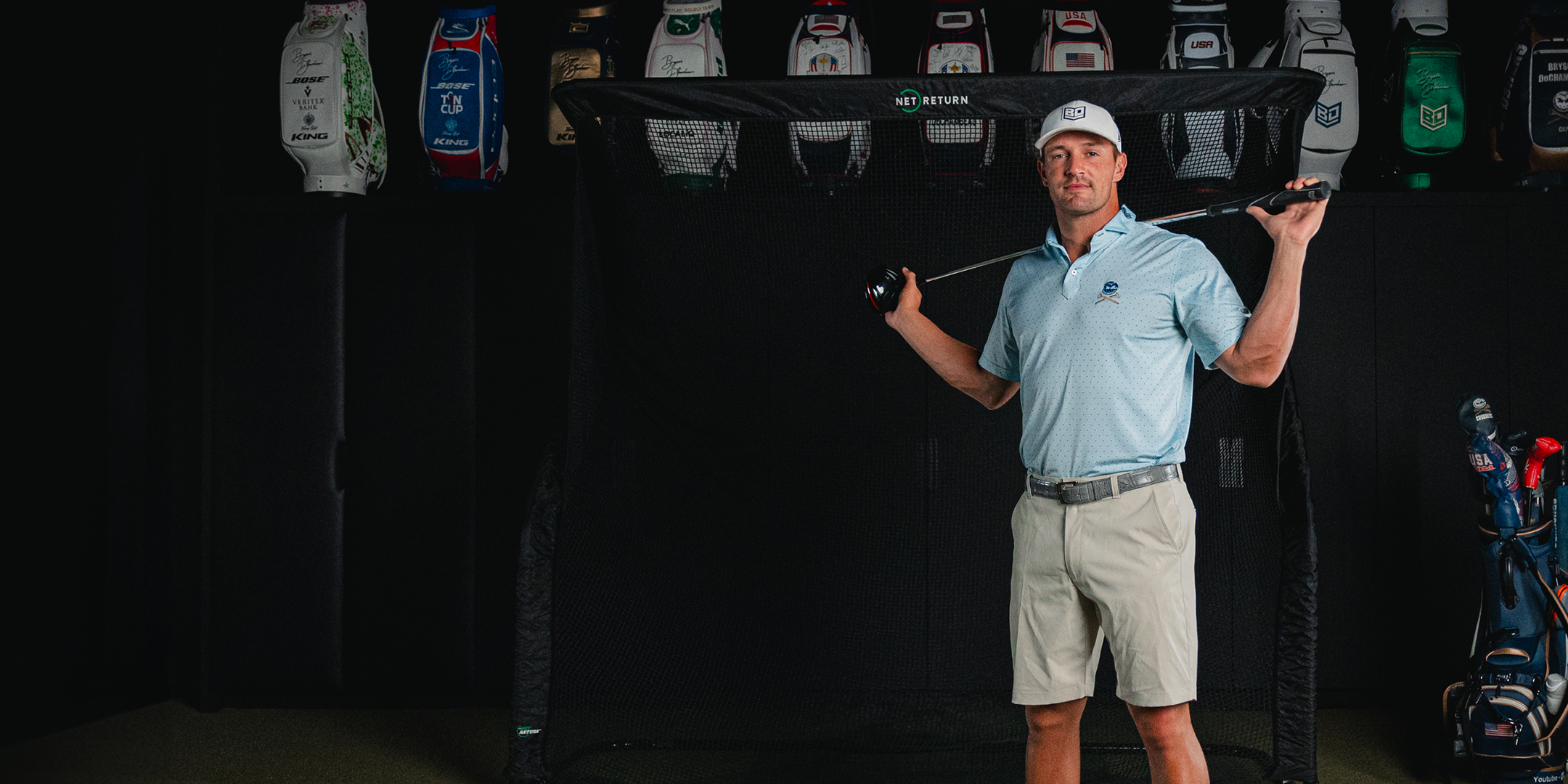Bryson DeChambeau is one of the most innovative and analytical golfers in the game today, blending power, precision, and science to gain a competitive edge. A two-time U.S. Open champion (2020, 2024), he has redefined modern golf through his unique training methods, data-driven approach, and relentless pursuit of speed and efficiency.
From mastering green reading to maximizing ball speed, Bryson’s methods offer valuable insights for golfers looking to refine their technique and improve performance. Let’s take a look at his top tips and training strategies to help golfers elevate their game.
The Bryson DeChambeau Video Series
Bryson has recorded several brief instructional videos with The Net Return, permitting fans a peek into his training techniques:
Gaining Distance Off the Tee
In this instructional video, Bryson DeChambeau shares a simple yet powerful technique for adding distance to your golf swing. Known for his ability to generate immense power off the tee, Bryson emphasizes that gaining distance isn’t just about swinging harder—it’s about optimizing sequencing and movement efficiency.
Key Tip: Relax at the Top, Then Rotate with Power
Bryson begins by demonstrating a smooth, controlled backswing, emphasizing the importance of feeling "soft" at the top. He advises golfers to take a little more time when reaching the top of their swing instead of rushing into the downswing. This relaxed position allows for better control and ensures a more efficient transition into the next phase of the movement.
The second aspect he highlights is the torso rotation into the left arm. As he transitions from the top of the swing, he focuses on turning his chest aggressively toward the target. This movement is essential for generating more clubhead speed and power, ultimately resulting in increased distance. However, Bryson also warns about a common mistake—over-rotating too early, which can cause an "over the top" motion leading to slices or mis-hits.
Why This Works
This technique leverages the kinetic chain, where energy transfers efficiently from the body to the club. By keeping the backswing relaxed and allowing a controlled chest rotation, golfers can achieve better timing, smoother acceleration, and more effective energy transfer at impact.
Golf Speed Training
Bryson puts his power-focused training to the test, pushing himself to achieve a staggering 200 mph ball speed. Known for his dedication to speed training and biomechanical precision, Bryson methodically works through a series of swings, with help from his TNR net. The session showcases the effort required to increase swing speed while maintaining control and consistency.
Why Ball Speed Matters in Golf
Ball speed is one of the most important factors in maximizing distance off the tee. Higher ball speeds translate to longer drives, giving golfers a significant advantage in reaching greens in fewer strokes. For elite players like Bryson, pushing the limits of ball speed allows him to shorten courses, gain strategic advantages, and improve scoring opportunities.
The Role of The Net Return in High-Speed Training
During his practice session, Bryson utilizes one of The Net Return’s high-performance training nets, capable of handling elite-level swing speeds. These heavy-duty golf nets not only absorb high-impact shots but also facilitates continuous practice by returning the ball efficiently.
With the ability to integrate with various launch monitors, The Net Return can help players track ball speed in real time, allowing for immediate feedback and adjustments. For golfers seeking the ideal at-home practice environment, The Net Return’s collection of simulator bays and packages include high-quality set-ups for players at all levels.
Golf Swing Feel
Bryson discusses an essential swing feel he focuses on during indoor practice: right wrist control. In another example of his scientific approach to golf, Bryson emphasizes the importance of understanding how the right wrist influences the clubface angle throughout the swing. His method highlights the role of wrist mechanics in maintaining control, consistency, and precision—vital elements in elite-level performance.
Why Wrist Control Matters in the Golf Swing
The position of the right wrist (for right-handed golfers) dictates how the clubface moves throughout the swing. If the wrist is too active or improperly positioned, it can lead to mis-hits, inconsistent ball flight, and poor shot control. By keeping awareness of his right wrist throughout the entire motion, Bryson ensures that his clubface remains stable, allowing him to strike the ball more effectively.
This level of control is especially important when working on indoor practice sessions, where feel-based training is typically emphasized over ball flight observation. By training his wrist mechanics, Bryson enhances his ability to return the clubface to a square position at impact, maximizing accuracy and consistency.
How Golfers Can Apply This Feel to Their Practice
For golfers looking to improve their ball-striking and control, focusing on wrist awareness can be a game-changer. Practicing with golf training aids like wrist trainers or using slow-motion drills to feel how the right wrist moves can help reinforce proper technique. Pairing this with a golf simulator kit or The Net Return can provide valuable real-time feedback, ensuring that adjustments lead to tangible results.
By refining wrist control, golfers can develop a more repeatable and reliable swing.
Training with a Golf Net
Bryson shares his primary focus when practicing indoors or hitting into a net—developing a strong sense of feel and repeatability in the golf swing. Without the ability to track ball flight directly, Bryson emphasizes the importance of paying attention to what you sense throughout the swing, ensuring that every shot is struck with square contact and consistency.
Why Feel Matters in Indoor Practice
When hitting into a golf net, many golfers focus too much on drills or mechanics without fully engaging with the sensation of their swing. Bryson highlights that, without seeing the ball flight, the best way to evaluate your practice is by tuning into how the clubface feels at impact. This means:
- Focusing on the quality of contact—a well-struck shot should feel solid and controlled.
- Noticing where the ball is consistently hitting the net—this helps determine if your shots are centered and repeatable.
- Evaluating your swing’s rhythm and mechanics—ensuring your motions feel right.
By developing greater sensory awareness, golfers can build muscle memory and improve their ability to reproduce a successful swing over and over.
How to Apply This to Your Training
To maximize indoor training, Bryson suggests golfers focus on their own unique swing feel rather than getting too caught up in rigid drills. Pairing this awareness with The Net Return, which automatically returns the ball for continuous practice, allows for efficient, focused sessions. Golfers can also integrate golf training aids, such as launch monitors or impact trainers, to gain additional insights.
By emphasizing contact quality and repeatability, golfers can make the most of their indoor golf practice, ensuring their swing remains consistent when they transition back to the course.
A Tee Drill
Bryson explains one of his favorite drills for improving ball-striking consistency when hitting into a golf net. This tee gate drill is a simple yet highly effective way to ensure centered contact on the clubface, helping golfers develop better control, accuracy, and consistency in their swings.
How the Tee Gate Drill Works
Set up two tees in the ground, positioned just wide enough for the toe and heel of the club to pass through cleanly during the swing. The goal is to swing the club through the gate without touching either tee, which ensures that the clubface remains square and makes contact with the center.
This drill provides instant feedback:
- If the club strikes the front (toe-side) tee, it means the golfer made contact toward the heel of the clubface.
- If the club strikes the back (heel-side) tee, it indicates contact on the toe of the clubface.
By consistently swinging through the gate without disturbing the tees, golfers can train themselves to strike the ball flush in the center of the clubface—leading to more solid, repeatable shots.
Why This Drill Is Effective for Indoor Training
The tee gate drill allows golfers to self-diagnose contact issues without needing advanced technology or launch monitors. This drill is particularly useful for players struggling with off-center strikes, helping them gain a better feel for the clubface and improving overall swing consistency. By incorporating it into regular practice, golfers can make measurable improvements in their golf net training sessions.
Bryson's Favorite Golf Book
As already noted, Bryson DeChambeau is well known for his scientific approach to golf, and much of his methodology can be traced back to his all-time favorite golf book, The Golfing Machine by Homer Kelley. This book, originally published in 1969, is one of the most technical and influential golf instruction texts ever written. It breaks down the golf swing into 24 components, each with multiple variations, allowing players to build a personalized, scientifically sound swing.
What Is The Golfing Machine About?
Unlike traditional golf instruction books, which often rely on feel-based coaching, Homer Kelley approached the swing from an engineering perspective. He viewed the golf swing as a mechanical system, where different moving parts could be adjusted based on a golfer’s individual needs.
The book identifies the laws of motion, leverage, and force that govern a repeatable, efficient golf swing. Kelley’s system allows golfers to find customized solutions rather than relying on a one-size-fits-all method.
Why Is This Book So Important to Bryson?
Bryson was introduced to The Golfing Machine by his longtime coach, Mike Schy, when he was 15 years old. The book resonated with him because of his analytical mind and passion for physics-based problem-solving. It provided a scientific framework for understanding the mechanics of the swing, leading him to develop his single-plane swing and the use of single-length irons—two defining characteristics of his game.
Bryson frequently credits the book with shaping his approach to golf. Unlike many players who rely on instinct, he treats golf as a series of controlled variables, testing different techniques to optimize efficiency and consistency. By following the principles in The Golfing Machine, he has been able to create a unique, repeatable swing that generates both power and precision.
For golfers who enjoy a structured, scientific approach to the game, The Golfing Machine offers a deep dive into swing mechanics and a fresh perspective on mastering golf that is still relevant today
Bryson's Bulk
One of the most discussed transformations in modern golf has been Bryson DeChambeau’s dramatic weight gain and subsequent downward adjustments—a calculated effort to increase swing speed, ball speed, and driving distance.
At the peak of his bulk in 2020, he weighed around 235 pounds, a significant increase from his early professional years. This additional muscle mass helped him generate over 200 mph ball speed, allowing him to dominate with longer drives and shorter approach shots.
How Mass Translates to Distance
It’s a simple concept: mass moves mass—the idea that a heavier, stronger golfer can generate more force in the swing, leading to higher clubhead speed and greater ball speed. Bryson’s transformation was not just about adding muscle but also about optimizing his biomechanics to maximize energy transfer. His efforts paid off, culminating in a staggering 221.5 mph ball speed at a 2021 Cobra media launch event—one of the fastest speeds ever recorded.
By increasing his power output, Bryson effectively shortened courses, often carrying 350+ yards off the tee. This advantage forced competitors to rethink their own training regimens and sparked debates about the role of strength in modern golf.
Challenges of Weight Gain in Golf
While bulking up has its benefits, it can also introduce several challenges:
- Reduced flexibility: More muscle can make it harder to maintain the fluidity and range of motion needed for a repeatable swing.
- Fatigue management: Swinging at extreme speeds requires enormous energy, which makes endurance a major factor over four rounds of tournament play.
- Swing adjustments: With increased size and strength, timing and sequencing has to be refined to prevent mis-hits.
Citing health concerns, Bryson has since adjusted his weight, slimming down to around 215 pounds in 2023 to strike a balance between power, mobility, and endurance. His transformation continues to be a case study in how modern golfers can optimize their physique for peak performance.
Studying the Greens
Bryson’s methodical approach to studying the greens has redefined the way professional golfers think about putting. Bryson’s green-reading strategy is another example of his ongoing pursuit of precision in golf. His analytical methods effectively forced the PGA Tour to ban protractors—a tool he used to help measure slopes on greens with extreme accuracy.
How Bryson’s Methods Changed the Game
In 2018, Bryson was seen using a protractor during a PGA Tour event to measure the angles of greens and better understand break and slope variations. The device allowed him to gather precise data that could help determine how putts would roll based on elevation changes, grass type, and grain direction.
However, the USGA ruled that such devices violated the spirit of the game and banned their use, arguing that green reading should rely on skill and feel rather than mechanical measurement tools.
Even without a protractor, Bryson’s studious approach to putting remains one of his greatest strengths. He studies green-reading books, uses AimPoint Express, and factors in stimp speed, wind, and moisture before making a putt. His ability to break down the physics of putting allows him to minimize errors and improve his lag putting.
Why Green-Reading Is So Important
For elite golfers, putting is where tournaments are won and lost. Even the slightest miscalculation in slope or speed can mean the difference between a birdie and a bogey. Bryson’s methodical approach has proven that green reading is both an art and a science, and his innovations—though controversial—have pushed players to think more critically about how they study the greens.
By combining feel with data-driven precision, Bryson DeChambeau continues to challenge conventional wisdom, showing that every stroke on the green can be optimized through careful analysis.
Daily Swing Practice with The Net Return
For Bryson, daily swing practice is an essential part of his pursuit of power, precision, and consistency. Whether he’s working on increasing ball speed, refining clubface control, or improving his short game, Bryson relies on a structured practice routine to maintain peak performance. A key component of his training is The Net Return. Our premium golf practice nets are designed for continuous, high-intensity, pro-level training both indoors and outdoors.
Why Bryson Trains with The Net Return
Bryson’s dedication to speed training and biomechanics means that repetition and instant feedback are essential to his success. The Net Return’s automatic ball return system enables him to take rapid, consecutive swings without having to reset after each shot. This allows him to focus on building muscle memory and optimizing his swing mechanics.
When Bryson practiced reaching 200+ mph ball speed, he used The Net Return to track his progress, with the extremely durable net safely containing his high-velocity shots. Since The Net Return is compatible with launch monitors and simulators, players can analyze real-time data on clubhead speed, ball speed, and launch angles—all essential metrics in the scientific approach to the game exemplified by Bryson DeChambeau.
How Golfers Can Benefit From The Net Return
For amateur golfers looking to train like Bryson, The Net Return provides an efficient way to practice full swings, chips, and even simulated approach shots from the comfort of home. Our golf nets’ durability and instant ball return make them ideal for daily training sessions, ensuring consistent ball-striking practice without the need for a driving range.
Bryson’s success proves that structured, high-quality practice leads to measurable improvement. Whether you’re working on swing speed, accuracy, or mechanics, The Net Return provides a professional-grade training tool that helps golfers refine their game just like the pros.
Putting Next to a Tape Measure
Bryson‘s scientific approach to golf is nowhere more evident than in his putting practice. Unlike many golfers who rely purely on feel, Bryson incorporates measured precision into every aspect of his training. One of his most effective techniques is putting next to a tape measure, or ruler, to ensure consistent stroke length, ball speed, and accuracy.
Why Bryson Uses a Tape Measure for Putting
Bryson’s putting philosophy is—again—rooted in repeatability. He believes that by controlling how far the putter moves on the backswing and follow-through, he can make putting a more predictable process. Using a tape measure allows him to:
- Standardize his stroke length for different distances, ensuring consistent tempo and acceleration.
- Develop a formulaic approach to putting, reducing reliance on feel and minimizing variability.
- Fine-tune distance control, particularly for lag putting on long putts where precision is crucial.
This method helps him create a measured system that translates into real-world performance on the greens.
How Golfers Can Use This Drill
For golfers looking to improve their distance control and consistency, practicing putting next to a tape measure or ruler can be a game-changer. It’s easy to set it up:
- Lay out a tape measure on the putting surface, extending 10-15 feet.
- Mark specific stroke lengths (e.g., 6 inches, 9 inches, 12 inches) and correlate them to different distances.
- Practice making putts using a controlled stroke length, ensuring consistent speed and contact.
Bryson’s approach proves that precision and structure can remove uncertainty from putting. By training with a tape measure, golfers can develop a reliable, repeatable stroke—just like one of the top players in the game today.
Bryson DeChambeau’s dedication to performance optimization has made him one of the most fascinating figures in the sport. The Net Return is proud to support Bryson in his relentless pursuit of excellence. As an ambassador for The Net Return, Bryson relies on our premium golf nets to enhance his daily practice, refine his swing, and push the limits of ball speed.
No matter where you are in your journey as a golfer, The Net Return offers the tools to train like Bryson and take your practice to the next level.





